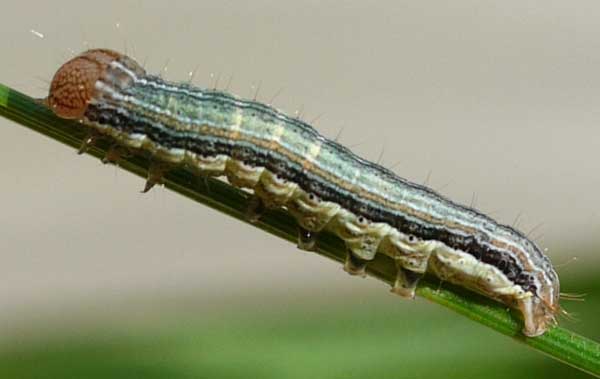TDI Blog
ARMYWORMS!
The fall armyworm is a devastating pest in the Southeast and can cause severe damage to turf grass and forage crops. Damage varies in appearance and severity according to the type of grass and management practices. They are most numerous in late summer or early fall.
More than 60 plants have been reported as hosts of the fall armyworm, including forage grasses, corn, alfalfa, cotton, soybeans, and most vegetable crops. There are two strains of the fall armyworm, the rice strain and the corn strain. The rice strain caterpillars feed on a variety of forage crops, but seem to prefer lush, green, well-fertilized bermudagrass. Other forage grasses that are hosts for fall armyworm are bahiagrass, pearl millet, sorghum-sudan hybrids, tall fescue, and various winter annuals including ryegrass, rye, wheat, and oats.
As the name indicates, fall armyworms are most numerous in late summer or early fall. Usually, reports of fall armyworm damage begin to come in during late July or early August. First reports are usually from southern Alabama. There are three or more generations of fall armyworm each year. Each generation takes about 30 days under Alabama's summer conditions. Occasionally, severe outbreaks occur as early as mid-April. Each year, fall armyworm moths, carried by air currents, make their way from southern Florida, southern Texas, and Central and South America. The size and timing of the initial moth flights are two factors that influence the outbreak potential of this pest.
Fall armyworms are typically most active early in the morning, late in the afternoon, or in early evening, but on taller, unmowed grass, they can be observed feeding on foliage throughout the day. On closely grazed or recently mowed hayfields, fall armyworm larvae spend the warmer hours of the day deep in the sod.
Established, healthy bermudagrass is rarely killed by fall armyworms, but the complete defoliation caused by a severe infestation weakens plants and deprives livestock of pasture or a hay producer of a hay cutting.
Fall armyworm damage on newly established grasses including winter annuals, tall fescue, or orchardgrass can be an even more serious situation. Seedlings of these fall-seeded plants are small when populations of fall armyworm are at seasonal highs. These crops can be severely stunted or killed if fall armyworms feed too far down on these plants.
If you are seeing armyworms in your lawn contact TDI for a service call to have your technician come and resolve the pests.
Subscribe to our blog to stay informed!
www.tdi.services |
When you subscribe to the blog, we will send you an e-mail when there are new updates on the site so you wouldn't miss them.






Comments